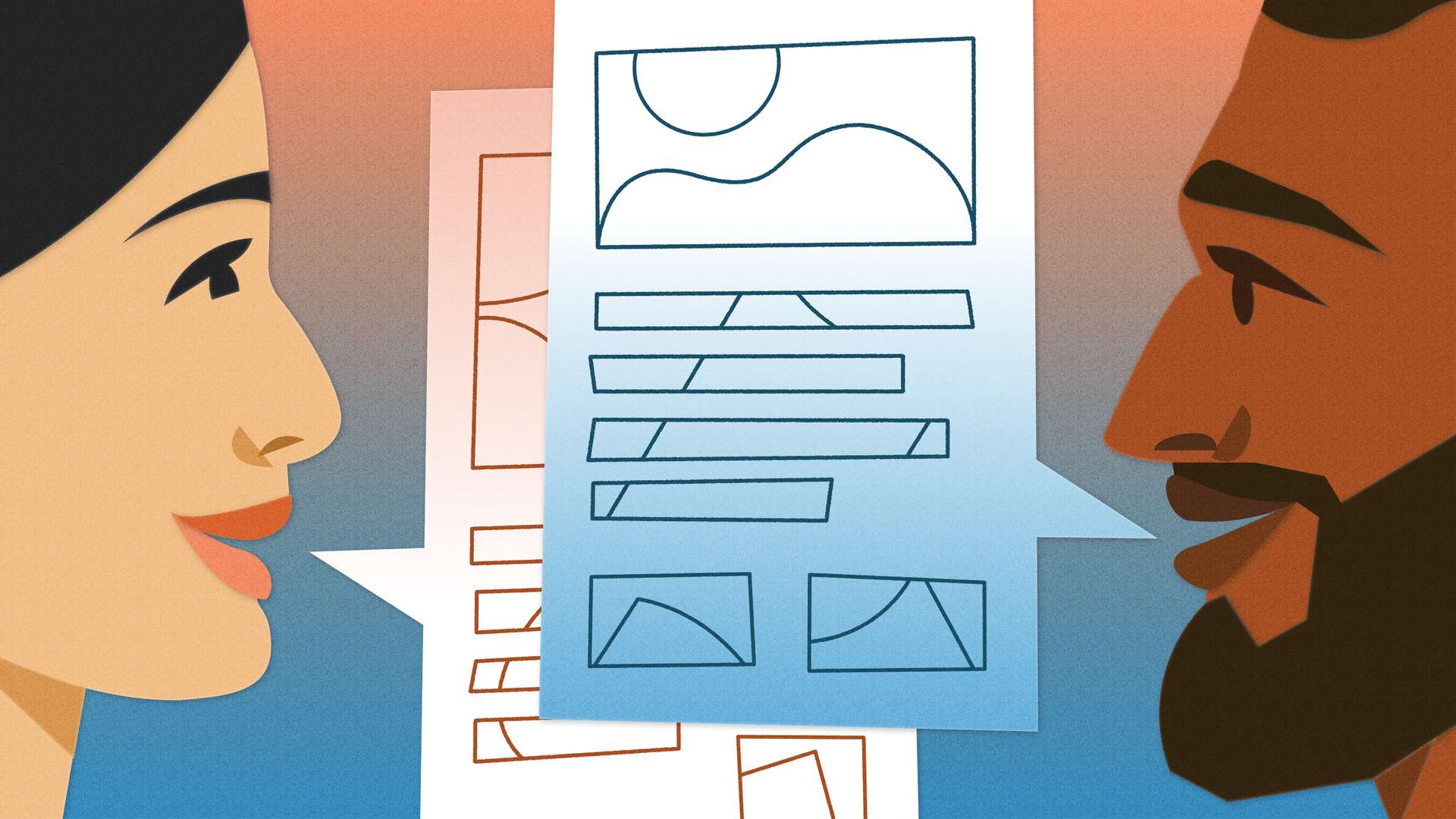Have you ever had a great conversation? The kind that makes you feel inspired and assured? Energized to take the next step and prepared for what that might be? In our interpersonal relationships, conversations are essential to developing mutual understanding and making progress. They jolt us forward. They help us build the relationships that enrich our lives.
So too in our interactions with technology. We may not notice the subtle conversational elements at play that guide us toward our goals, but they’re embedded along the journey of a trustworthy digital experience. As my friend Phillip Jo, senior manager of experience design at Capital One, puts it, “Design helps solve the right problem at the right time.” As in any design, the conversational elements of an experience can help solve the right problem at the right time, too.
Earlier in my career, I had the chance to study conversations and apply certain tactics to designing conversational artificial intelligence. I’ve seen these strategies help teams design truly innovative experiences, and I’m excited to share them. With the purpose of designing trustworthy experiences based on lessons from conversations, here are three steps to designing conversational UX.
Wait, what is conversational UX?
Conversational UX requires a big-picture understanding of the landscape of both the frontstage, or what a recipient of a service sees, and the backstage, the behind-the-scenes work happening to generate their experience. It’s the interaction layer on top of an ecosystem that incorporates a range of device types. Wearables, intelligent assistants, augmented or virtual reality -you name it. The idea is not to confine design to an interface, but to ensure human-centric design is woven throughout an entire design ecosystem.
Put succinctly by Rebecca Shapiro, a leader of my current team and director of UX at Indeed, “UX, at its heart, is facilitating interplay or conversations between people, or between people and technology. UX Design and Content Design are just UX through two different lenses, language or visible interactions—both of which are of critical, strategic importance.” To facilitate this interplay, we need to blend lessons from a range of design disciplines together in the service of solving the right problem at the right time. I call this blend of UX and content design “conversational UX.”
Building trust should animate the pursuit of great conversational UX.
Great conversational UX doesn’t require messaging a bot or texting via SMS with a business. Regardless of the interface you interact with, you know you’re dealing with a well-designed conversational experience when a service anticipates your priorities, provides help at the moment you need it, and makes you feel on top of your life (if only for a moment).
The conversational elements of a well-designed service, product, and experience may include:
- A connected suite of different types of devices that feel integrated with an existing environment
- Text that guides someone through the connection of one device to another
- A consistent voice and an empathetic tone
- Suggestions that are helpful and logical rather than imposing or confusing
- An experience that earns trust
Building trust should animate the pursuit of great conversational UX. An experience can serve a business purpose while embodying relevance, clarity, empathy, and focus to guide someone toward their goal. This is at the center of a well-designed ecosystem where a consistent voice drives a user from one step to another. Ultimately, trust allows for a lasting relationship to develop as the product continuously meets evolving needs.
Conversational UX is already happening across the interconnected ecosystems of devices we regularly interact with. Now, it’s time for more of us to understand how to maximize it. Here are a few steps to doing that.
Step 1: Define the purpose
Ever heard Simon Sinek speak about starting with why? A great place to begin anything, including designing a conversational experience, is with its purpose.
Purpose is motivating
An unspoken motivating factor in any experience or conversation is a connection to a clear purpose. A website with local transit times can help achieve the purpose of getting you to work on time. A shopping app can help you buy groceries remotely for a neighbor in need. A cafe can help you meet with a long-time friend you haven’t seen in years. Defining a purpose is not just about what the service or product can do, it’s about why it matters to the people who use it.
At Indeed, our purpose is clear: We help people get jobs. And as designers at Indeed, we’re aware that this purpose should weave itself throughout every interaction people have with our business. Starting here can help align teams on a new project. And ultimately determine how the world will be better if you succeed.
For example, if you’re designing a series of products whose purpose is to improve people’s health, then the goal of the experience might be to make it consistently easy for someone to track their heart rate. You might imagine their heart-rate tracker displaying the same data in a similar way on their phone, smart watch and workout machine. Even if the purpose isn’t stated explicitly on a page or a screen, it can be communicated across an experience by what info. is available when.
The purpose is why you’re designing something, but the next step to building trustworthy experiences requires knowing when to interact. Here’s a way to ensure you’re meeting people where they are and solving the right problems at the right time.
Step 2: Uncover the right context
You might have heard of the 3 L’s of real estate. Say it with me:
Location, location, location.
To provide someone with the right information at the right time, it’s important to consider their location. That means finding the most relevant place to deliver information, whether that be a placement on a screen, an outbound channel, their physical location, and even their mental state. These different aspects of a person’s context will inform how they react to an experience.
Physical location matters
Let’s say you just pulled up to the airport in the backseat of a rideshare. Your purse is in one hand, phone is in the other, and you still need to grab your bag from the trunk of the car before you can rush to the security line. With your hands full, your phone has an added dimension of immediate value when it pushes a notification with a boarding pass to your lock screen. That context is essential. An hour too early, and you’d ignore it. And an hour too late, you’d be frustrated if you missed the flight. So, a notification with a boarding pass is delightful upon first entering the vicinity of the airport.
—
Is this article helpful? Subscribe to get occasional emails with new stories like it.
—
Location on a screen matters, too
Imagine you’re reading an email with a wedding invitation that includes a link to the couple’s registry. That’s a desirable and legitimate digital location for that link. But what if you read the email, forget to RSVP and then see the grooms-to-be post pictures on Instagram of a recent trip? The couple is top of mind, and they’re the type of people you want to celebrate! Wouldn’t it be helpful to see the options to RSVP directly on Instagram? (As in the previous example, I have no ties to these design processes, so these ideas are speculative.)
In both of these situations, a positive experience hinges on location. To find a desirable location, focus intently on the user. While I won’t dig into all of the possible research methods that could apply here, I think these questions can help unveil someone’s context.
Key questions to uncover context
- Where are they?
- What do they need to accomplish right now?
- What’s in their way?
- How are they feeling?
- What can you offer them?
- When can you let them know?
Every project is different, but here’s how these questions apply to the airport example:
- Where are they?
- Arriving at the airport
- What do they need to accomplish right now?
- Collect their things and make it to the gate in time
- What’s in their way?
- Hands full, time constraint, people traffic, stress, etc.
- How are they feeling?
- Stressed
- What can you offer them?
- The peace of mind that as long as their phone is nearby, the boarding pass will be easy to find
- When can you let them know?
- Surface a static notification on the lock screen within a certain vicinity of the airport
And here’s how they’d apply to the RSVP example:
- Where are they?
- Using Instagram
- What do they need to accomplish right now?
- RSVP for a wedding
- What’s in their way?
- The link to RSVP is somewhere deep in their inbox, but they’re on Instagram
- How are they feeling?
- Somewhat inspired? Awkward?
- What can you offer them?
- Make it easy to RSVP from the couple’s post in Instagram
- When can you let them know?
- Include some call to action to RSVP for a wedding from a post.
I hope this breakdown helps you see how understanding a user’s location can trigger conversational UX and set the stage for truly innovative experiences. It’s also a jumping-off point for more research and design methods.
But like Kate Murphy describes in her book, “You’re Not Listening,” listening carefully to someone else’s needs is a catalyst for meaningful connections. In our case, that’s true for meaningful design. Once you’ve uncovered where your user is and what they need now, knowing what you can provide or say next will become easier.
Designing conversational UX starts with knowing your purpose and how you’re solving people’s problems—then, empathetically meeting them where they are.
Step 3: Respond with the essentials
Using a repeatable framework for sharing the right information effectively can make it easier to design and scale trustworthy experiences. This can involve highlighting the most important information first and using a core set of principles to drive each response. We know people don’t want to waste time online, so providing the right information up top can amplify ease of use. Plug that in with a core set of principles, and you’re set.
The basic elements of conversation
Here’s an academic framework that’s a bare-bones framework for conversation, called Grice’s Maxims:
- The maxim of quantity, where one tries to be as informative as one possibly can, and gives as much information as is needed, and no more.
- The maxim of quality, where one tries to be truthful, and does not give information that is false or that is not supported by evidence.
- The maxim of relation, where one tries to be relevant, and says things that are pertinent to the discussion.
- The maxim of manner, when one tries to be as clear, as brief, and as orderly as one can in what one says, and where one avoids obscurity and ambiguity.
Put in a more conversational way:
- Keep it short and sweet
- Be honest
- Be relevant
- Make it easy to understand
Honesty, accuracy, relevance, and clarity can elevate an experience from something that works to something that is worthy of lasting trust. It’s my secret sauce for contributing to the products I work on, and I believe these principles, when used correctly, are key to building trust.
Our work can make a positive or a negative impact on real people
Among the many lessons in Ingrid Fetell Lee’s book, “Joyful,” she speaks to how our environments impact our overall well-being. Even if we think we’re designing just one small feature, we have the potential to influence someone’s world and their well-being by designing an interaction they have in their daily life. I wish I didn’t need to say this, but design should not exclude entire groups of people, capitalize on weaknesses by being addictive, or lower someone’s self esteem. Building trust for its own sake is different from building something trustworthy. Just like in a conversation, someone worthy of trust has your best interests in mind. When designing a conversational experience, building trust should always serve the goal of improving people’s lives.
Build trust with a well-designed conversation
Purpose, context, and a value driven content structure are key to designing trustworthy experiences. Designing conversational UX starts with knowing your purpose and how you’re solving people’s problems—then, empathetically meeting them where they are. When you present your purpose in a clear and honest way, it feels like a great conversation. And like a great conversation, great design should be accessible and collaborative so it solves the right problem at the right time—ultimately serving the higher purpose of making people’s lives better.
So, how will conversations inspire what you design next?





